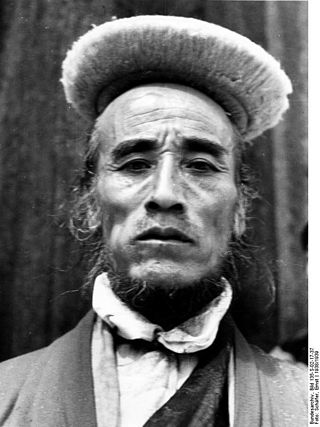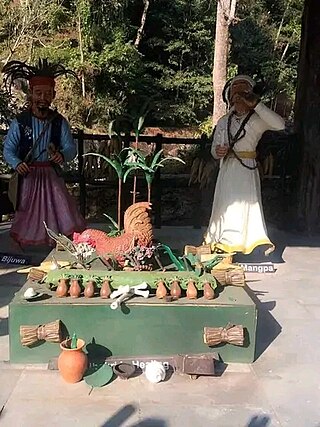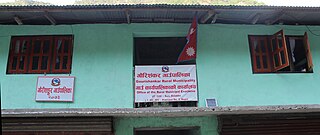
The Rai also known as Khambu and Jimee are ethnolinguistic group belonging to the Kirat family and primarily Tibeto-Burman linguistic ethnicity. They mainly reside in the eastern parts of Nepal, the Indian states of Sikkim, West Bengal and in southwestern Bhutan.
The Jirels is an ethnic Kirati group. Jirel are one of the 59 indigenous peoples in Nepal. They like to be called Jirpa, which means "leopard-like people." Jirpa believe that they migrated to Nepal, Jiri, and Dolakha from the western part of Nepal. Jiri, the name of the place, came from Jirpa. They are the original inhabitants of Jiri and its adjoining villages in Dolkha district, the central region of Nepal. They have their own distinct language, culture, customs, rituals and lifestyles. They are mostly Buddhist but many of the Jirel adhere to other religions, like Christianity, Islam and Hinduism. They also worship Jhakri (shamans). Their indigenous shamanistic religious beliefs are centered on practitioners called Phombo, who are believed to have a direct relationship with the supernatural world. Their main occupation is agriculture and animal husbandry. In recent years they have also been involved in business, government, and teaching jobs. Many of the Jirel are in the British Gurkha Army, Indian Army, Nepalese Army, and the police. They are primarily settled in Dolakha, Sindhupalchowk Chitwan, and Ilam districts, next to Likhu, Khimti, the Jiri and Jiri Shikri rivers. Jirels have linguistic and ethnic semblance with the Sherpas and the tribes of Central Tibet. Jirels have their own mother tongue which is called Jirpa Kecha, and belongs to the Tibetan language family.

Bhotiya or Bhot is an Indian and Nepali exonym lumping together various ethnic groups speaking Tibetic languages, as well as some groups speaking other Tibeto-Burman languages living in the Transhimalayan region that divides India from Tibet. The word Bhotiya comes from the classical Tibetan name for Tibet, བོད, bod. The Bhotiya speak numerous languages including Ladakhi, Drejongke, Yolmo and Sherpa. The Indian recognition of such language is Bhoti / Bhotia having Tibetan scripts and it lies in the Parliament of India to become one of the official languages through Eighth Schedule of the Indian Constitution.

Dolakha, often known as Dolkha or Dholkha ),a part of Bagmati Province, is one of the seventy-seven districts of Nepal. The district, with Charikot as its district headquarters, covers an area of 2,191 km2 (846 sq mi) and had a population of 204,229 in 2001 and 186,557 in 2011. Dolkha postal code begins from 45500 and the main headquarters is in Dolkha. The administrative center of this district consists of 11 post offices. It is a district with a strong religious affiliation. It is popularly known amongst most Nepalese for the temple of Dolakha Bhimeshawor.
Darjeeling district's population today is constituted largely of the descendants of the indigenous and immigrant labourers that were employed in the original development of the town. Although their common language, the Nepali language, has been given official recognition at the state and federal levels in India, the recognition has brought little economic progress to the region, nor significant political autonomy. A culture of both pride and dependence has evolved in the tea plantations where jobs have levelled off but housing can be inherited by a worker within the family. The population of Darjeeling meanwhile has grown substantially over the years. Many young locals, educated in government schools, have taken to migrating out for the lack of employment matching their skills. Like out-migrants from other regions of northeastern India, they have been subjected to discrimination and racism in some Indian cities.
The Nepalese caste system is the traditional system of social stratification of Nepal. The Nepalese caste system broadly borrows the classical Hindu Chaturvarnashram model, consisting of four broad social classes or varna: Brahmin, Kshatriya, Vaishya, Sudra.

The Digital Himalaya project was established in December 2000 by Mark Turin, Alan Macfarlane, Sara Shneiderman, and Sarah Harrison. The project's principal goal is to collect and preserve historical multimedia materials relating to the Himalaya, such as photographs, recordings, and journals, and make those resources available over the internet and offline, on external storage media. The project team have digitized older ethnographic collections and data sets that were deteriorating in their analogue formats, so as to protect them from deterioration and make them available and accessible to originating communities in the Himalayan region and a global community of scholars.

The Kirati people, also spelled as Kirant or Kiranti, are Sino-Tibetan ethnolinguistic groups living in the Himalayas, mostly the Eastern Himalaya extending eastward from Nepal to North East India.
The Dhimal or Dhemal are ethnic group residing in the eastern Terai of Nepal and West Bengal of India. They are a Sino-Tibetan-speaking ethnic group of the eastern Terai. They mainly reside in Morang and Jhapa districts of Nepal and Darjeeling district of West Bengal, India. They are respected as the "First Nepalese Citizens" of Damak municipality and are also Scheduled Indian tribes in West Bengal.

Mark Turin is a British anthropologist, linguist and occasional radio broadcaster who specializes in the Himalayas and the Pacific Northwest. From 2014–2018, he served as Chair of the First Nations and Endangered Languages Program and Acting Co-Director of the Institute for Critical Indigenous Studies at the University of British Columbia in Vancouver. He is an Associate Professor at the University of British Columbia, cross-appointed between the Department of Anthropology and the Institute for Critical Indigenous Studies. Turin served as Interim Editor of the journal Pacific Affairs from 2023-2024.

Kirat Mundhum, also known as Kiratism, or Kirati Mundhum, is a traditional belief of the Kirati ethnic groups of Nepal, Darjeeling and Sikkim, majorly practiced by Yakkha, Limbu, Sunuwar, Rai, Thami, Jirel, Hayu and Surel peoples in the north-eastern Indian subcontinent. The practice is also known as Kirat Veda, Kirat-Ko Veda or Kirat Ko Ved. According to some scholars, such as Tom Woodhatch, it is a blend of shamanism, animism, and Shaivism. It is practiced by about 3.17% of the Nepali population as of 2021.

Bhimeshwar,, is a municipality in north-eastern Nepal and the headquarters of Dolakha District in Bagmati Province that was established in 1997 by merging the former Village development committees Charikot, Dolakha Town, Makaibari, Mati, Suspaa, and Lankuri danda. At the time of the 2011 Nepal census, it had a population of 32,486 people living in 8,639 individual households. The town is located at an altitude of 1,554 metres (5,101 feet). The name of the district Dolakha came from Dolakha Town situated north-east of the headquarters Charikot Bazaar.
Bigu is a former village development committee that is now a ward-7 rural municipality in Dolakha District in Bagmati Province of northeastern Nepal. At the 1991 Nepal census, Bigu had a population of 1,736 people living in 361 individual households.
Melung is a Rural municipality located within the Dolakha District of the Bagmati Province of Nepal. The municipality spans 86.54 square kilometres (33.41 sq mi) of area, with a total population of 20,210 according to a 2011 Nepal census.
Thangmi, also called Thāmī, Thangmi Kham, Thangmi Wakhe, and Thani, is a Sino-Tibetan language spoken in central-eastern Nepal and northeastern India by the Thami people. The Thami refer to their language as Thangmi Kham or Thangmi Wakhe while the rest of Nepal refers to it as Thāmī. The majority of these speakers, however, live in Nepal in their traditional homeland of Dolakhā District. In India, the Thami population is concentrated mostly in Darjeeling. The Thangmi language is written using the Devanagari script. Thangmi has been extensively documented by Mark Turin.

Bagmati Province is one of the seven provinces of Nepal established by the constitution of Nepal. Bagmati is Nepal's second-most populous province and fifth largest province by area. It is bordered by Tibet Autonomous Region of China to the north, Gandaki Province to the west, Koshi Province to the east, Madhesh Province and the Indian state of Bihar to the south. With Hetauda as its provincial headquarters, the province is also the home to the country's capital Kathmandu, is mostly hilly and mountainous, and hosts mountain peaks including Gaurishankar, Langtang, Jugal, and Ganesh.

Gaurishankar, a part of Bagmati Province, Nepal, is a rural municipality located in Dolakha District. With Suri as its current official headquarters, the rural municipality consists of nine wards covers an area of 681.39 km² and has a population of 17,062 in 2011.
Tripurasundari is an urban municipality located in Dolpa District of Karnali Province of Nepal.

Dolakha Bhimsen Temple is located in the Bhimeshwar municipality of Dolakha in Nepal, approximately 4.5 km (2.8 mi) east of Charikot. The temple is roofless in the center and it houses a triangular-shaped stone idol of Bhindyo, the patron god of trade, commerce and of fortunes. The Newar community in general and the business community in particular revere the deity for good business. The idol is believed to resemble three deities: Bhimeshwar in the morning, Mahadeva throughout the day, and Narayana in the evening. The temple attracts around 5,000 worshippers every week.

Kalinchowk is a Rural municipality located within the Dolakha district of the Bagmati province of Nepal. The municipality spans 132.49 square kilometres (51.15 sq mi) of area, with a total population of 22,954 according to a 2011 Nepal census.












